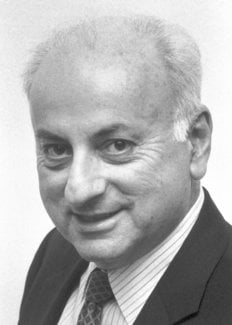Melvin Schwartz
Biographical

Having been born in 1932, at the peak of the great depression, I grew up in difficult times. My parents worked extraordinarily hard to give us economic stability but at the same time they managed to instill in me two qualities which became the foundation of my personal and professional life. One is an unbounded sense of optimism; the other is a strong feeling as to the importance of using one’s mind for the betterment of mankind.
My interest in Physics really began at the age of 12 when I entered the Bronx High School of Science in New York. That school has become famous for the large number of outstanding individuals it has produced including among them four Nobel Laureates in Physics. The four years I spent there were certainly among the most exciting and stimulating of my life, mostly because of the interaction with other students having similar background, interest and ability. It’s rather amazing how important the interaction with the one’s peers can be at that age in determining one’s direction and success in life.
Upon graduating from high school the path to follow was fairly obvious. The Columbia Physics Department at that time was unmatched by any in the world. Largely a product of the late Professor I.I. Rabi, it was a-department which was to provide the ambiance for six Nobel Prize pieces of work in widely diverse fields during the next thirteen years. And, in addition, it was the host for a period of time to another half dozen or so future Nobel Laureates either as students or as post-doctoral researchers. I know of no other institution either before or since that has come close to that record.
Thus, it was that I became an undergraduate at Columbia in 1949, to stay there through my graduate years and take up a faculty position as Assistant Professor in 1958. I became an Associate Professor in 1960 and a Professor in 1963.
In order for me to put my life into perspective, I must mention four individuals who have given it meaning, direction and focus. Foremost among these is my wife Marilyn whom I married 35 years ago and who has provided the one most enduring thread throughout these years. Without her constant encouragement and enthusiasm there would have been far less meaning to my life. The second is of course Jack Steinberger. Jack was my teacher, my mentor and my closest colleague during my years at Columbia. Whatever taste and judgement I have ever had in the field of Particle Physics came from Jack. Third of course is T.D. Lee. He was the inspirer of this experiment and the person who has served as a constant sounding board for any ideas I have had. He has also become, I am proud to say, a dear personal friend. And finally, my close collaborator Leon Lederman. If there is any one person who has served as the sparkplug for high energy physics in the U.S. it has been Leon. I am proud to have been his collaborator.
In 1966, after having spent 17 years at Columbia, I decided to move West to Stanford, where a new accelerator was just being completed. During the ensuing years I was involved in two major research efforts. The first of these investigated the charge asymmetry in the decay of the long-lived neutral kaon. The second of these, which was quite unique, succeeded in producing and detecting relativistic hydrogen-like atoms each made up of a pion and a muon.
During the 1970’s, lured in part by the new industrial revolution in “Silicon Valley” I decided to try my hand at a totally new adventure. Digital Pathways, Inc. of which I am currently the Chief Executive Officer is a company dedicated to the secure management of data communications. Although it is difficult to predict the future I still have all the optimism that I had back when I first grew up in New York-life can be a marvelous adventure.
(added in 1991): A new change in my career occurred in February 1991 when I became Associate Director, High Energy and Nuclear Physics, at Brookhaven National Laboratory.
This autobiography/biography was written at the time of the award and first published in the book series Les Prix Nobel. It was later edited and republished in Nobel Lectures. To cite this document, always state the source as shown above.
Melvin Schwartz died on August 28, 2006.
Nobel Prizes and laureates
Six prizes were awarded for achievements that have conferred the greatest benefit to humankind. The 12 laureates' work and discoveries range from proteins' structures and machine learning to fighting for a world free of nuclear weapons.
See them all presented here.
